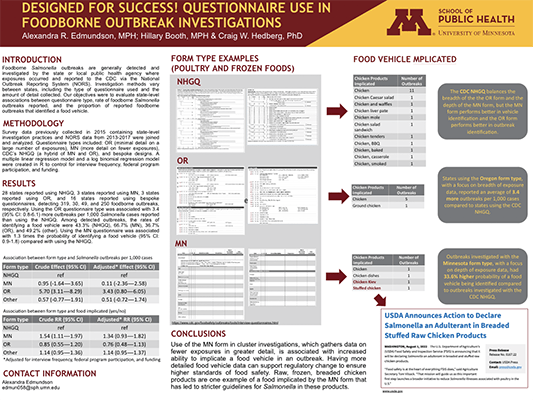Alexandra Edmundson
PhD, Environmental Health
Co-Authors:
Hillary Booth, MPH; Craig W. Hedberg, PhD
Advisor:
Craig W. Hedberg
Keywords:
Salmonella, outbreak
Abstract
Background
Foodborne Salmonella outbreaks are generally detected and investigated by the state or local
public health agency where exposures occurred and reported to the CDC via the National
Outbreak Reporting System (NORS). Investigation methods vary between states, including the
type of questionnaire used and the amount of detail collected. Our objectives were to evaluate
state-level associations between questionnaire type, rate of foodborne Salmonella outbreaks
reported, and the proportion of reported foodborne outbreaks that identified a food vehicle.
Methods
Previously collected survey data containing state-level investigation practices and NORS data
were joined and analyzed. Questionnaire types included: OR (minimal detail on a large number
of exposures), MN (more detail on fewer exposures), CDC’s NHGQ (a hybrid of MN and OR), and
bespoke designs. A multiple linear regression model and a log binomial regression model were
created in R to control for interview frequency, federal program particiption, and funding.
Results
28 states reported using NHGQ, 3 states reported using MN, 3 states reported using OR, and 16
states reported using bespoke questionnaires. Using the OR questionnaire type was associated
with 3.4 (95% CI: 0.8-6.1) more outbreaks per 1,000 Salmonella cases reported than using the
NHGQ. Using the MN questionnaire was associated with 1.3 times the probability of identifying
a food vehicle (95% CI: 0.9-1.8) compared with using the NHGQ.
Conclusion
Casting a wider net to ascertain potential exposures increased the rate of reporting foodborne
outbreaks but increasing exposure details about individual exposures increased the likelihood of
identifying the food vehicle.
Support
This study was supported by Minnesota Integrated Food Safety Center of Excellence

